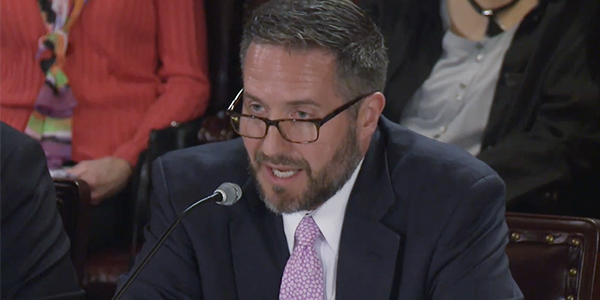By Christen Smith
HARRISBURG, Pa. — Critics of a bill to subsidize Pennsylvania’s failing nuclear fleet on Monday advised state lawmakers to put the brakes on the proposal, saying it would distort the deregulated energy markets it worked long to build.
Glen Thomas, president of GT Power Group, testified before the House Consumer Affairs Committee that House Bill 11 upends two decades of regulatory and legislative work and wastes $12 billion in stranded costs spent transitioning to a competitive wholesale power marketplace.
“It’s an absolute competition killer,” he said. “It’s a big deal. It’s a very complicated piece of legislation … that undoes a lot of the hard work it took to get us here.”
HB 11 would create a third tier of resources in the state’s Alternative Energy Portfolio Standard (AEPS) program from which retail providers must purchase at least 50% of their electricity by 2021: nuclear, solar, geothermal and low-impact hydropower. The first two tiers of the legislation include 16 resource types with targets of 8% and 10%.
Prime sponsor Rep. Thomas Mehaffie (R) said the plan would provide consumer protections through capped pricing and the prevention of “double dipping” across programs. He estimated the bill would cost $500 million — one-eighth of the $4.6 billion in annual costs he claims would result should all five nuclear plants in the state shut down: $788 million in higher electric prices; $2 billion in lost GDP; and $1.86 billion in costs associated with carbon emissions and harmful criteria air pollutants, including SO2, NOX and particulate matter. (See Pa. Lawmakers Unveil $500M Nuke Subsidy Bill.)
Exelon will begin the four-month process of shutting down Three Mile Island near Harrisburg in June if lawmakers fail to act. FirstEnergy will retire Beaver Valley in 2021 in what the company described as a growing trend during its testimony before the committee on Monday.
“On one hand, emitting plants get to pollute for free, not bearing any of the cost of the pollution they put into the air or water,” said Dave Griffing, vice president of government affairs for FirstEnergy Solutions. “And on the other hand, 16 other forms of technology get a payment, some as high as $55[/MWh], from the federal and state government through tax credits and AEPS credits. The result is not shocking. Pennsylvania nuclear facilities and others across the country have their hands tied behind their backs and are facing early retirement.”
Critics of the plan argue there’s better, cheaper ways to reduce carbon emissions and insist that subsidizing nearly 70% of the market props up aging nuclear reactors at the expense of competition.
“This is a major shift in Pennsylvania’s energy policy from a policy that puts consumers in the driver’s seat to one that puts policymakers in the driver’s seats by dictating where their energy comes from,” Thomas said, noting he’s spent the majority of the last 15 years convincing other states to deregulate their energy markets like Pennsylvania has. “HB 11 puts the thumb on the scale for 68% of the delivered megawatts in this state if approved.”
Tom Ridge, former secretary of Homeland Security, and Pennsylvania governor from 1995 to 2001, said preserving the state’s five nuclear facilities maintains reliability. He signed the 1996 bill deregulating the state’s energy markets and allowing it to join PJM.
“I’ve always believed in a diversified portfolio,” he told lawmakers Monday. “We want competitive markets and competitive markets need multiple sources of generation. Other states are doing it because they can’t wait on the feds to do it. In five or six years, we may not have these facilities left.”
Todd Snitchler, vice president of market development for the American Petroleum Institute, said PJM’s generation portfolio will remain balanced, even as trends shift away from nuclear energy. Last month, the Independent Market Monitor said gas-fired energy output exceeded coal in PJM last year for the first time, though sources remain relatively balanced among gas (30.9%), coal (28.6%) and nuclear (34.2%), with renewables accounting for a small but growing share of less than 3%.
“A concern about a dash to gas needs to be tempered by realities on the ground,” he said.
The committee will host a second public hearing on HB 11 in Harrisburg on April 15.
The Senate version of the bill, SB 510, was introduced last week by Sen. Ryan Aument (R). That bill differs from the House version in that it directs the state’s Public Utility Commission to set credit prices and guarantee that between 17 and 23% of Tier III sources purchased include non-nuclear suppliers, like wind and solar. (See related story, Pa. Lawmakers Introduce 2nd Nuke Subsidy Bill.)







